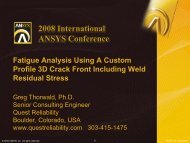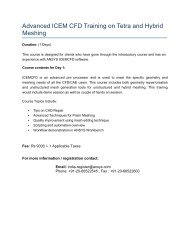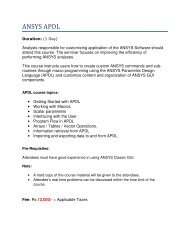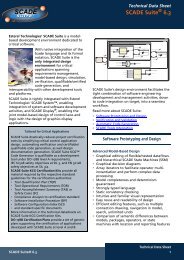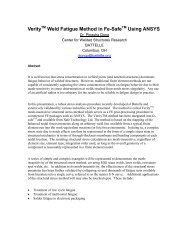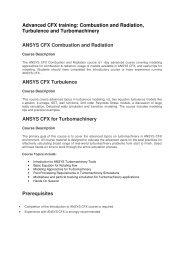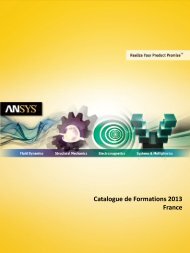Simulation - ANSYS
Simulation - ANSYS
Simulation - ANSYS
Create successful ePaper yourself
Turn your PDF publications into a flip-book with our unique Google optimized e-Paper software.
BOOK REVIEWS<br />
Learning to Work with<br />
<strong>ANSYS</strong> Workbench<br />
Tutorials help both novices and experienced users understand<br />
the ins and outs of this simulation platform.<br />
By Rajesh Bhaskaran, Director, Swanson Engineering <strong>Simulation</strong> Program, and Professor, Mechanical and Aerospace Engineering,<br />
Cornell University, New York, U.S.A.<br />
In my work at Cornell University, I have been using<br />
traditional <strong>ANSYS</strong> Mechanical software for the last seven<br />
years to teach students the basics of finite element analysis<br />
(FEA) applications. Recently, a few passing encounters with<br />
the <strong>ANSYS</strong> Workbench platform — mostly through students<br />
returning from industry stints — piqued my interest in<br />
the sleek, modern interface. Two new books published<br />
by Schroff Development Corporation helped me cut my teeth<br />
on <strong>ANSYS</strong> Workbench release 11.0: <strong>ANSYS</strong> Workbench<br />
Tutorial by Kent Lawrence and <strong>ANSYS</strong> Workbench Software:<br />
Tutorial with Multimedia CD by Fereydoon Dadkhah and<br />
Jack Zecher.<br />
<strong>ANSYS</strong> Workbench Tutorial<br />
Lawrence’s book kicks off with three chapters on solid<br />
modeling using the <strong>ANSYS</strong> DesignModeler package. The<br />
first few tutorials cover solid model creation through extrusion,<br />
revolution and sweeping of an L-shaped cross section.<br />
Modeling an assembly is demonstrated through the<br />
creation of a three-part clevis yoke assembly. It is well worth<br />
the time it takes to complete this tutorial successfully, since<br />
the book uses this model in a subsequent tutorial on<br />
simulation. The solid modeling portion of the book wraps<br />
up with exercises on parameters and surface/line models.<br />
The <strong>ANSYS</strong> Workbench interface simplifies working with<br />
computer-aided design (CAD) models created in other<br />
programs, and Lawrence briefly covers this topic in two<br />
separate places. I expect to be referring students to this<br />
coverage often.<br />
FEA coverage begins in chapter 4 with an introduction<br />
to the <strong>ANSYS</strong> <strong>Simulation</strong> module. The book assumes that<br />
readers already know the fundamentals of FEA, and it<br />
launches straight into the tutorials. The first considers the<br />
classic problem of a plate with a central circular hole — a<br />
favorite of college professors. This tutorial solves a 3-D<br />
plate model with finite thickness using solid elements.<br />
Results are verified by comparing with published<br />
stress concentration factors and plotting estimates of<br />
the structural error, a very useful parameter.<br />
40<br />
<strong>ANSYS</strong> Advantage • Volume II, Issue 2, 2008<br />
The next tutorial considers the case of a square hole, as<br />
opposed to a circular one. The effect of the stress singularity<br />
at the corner of the square hole is explored through the<br />
automated mesh convergence capability in the <strong>ANSYS</strong><br />
Workbench environment. This powerful feature successively<br />
refines the mesh until a selected solution quantity changes<br />
by less than a specified percentage. The author explains<br />
how to eliminate the stress singularity by adding a fillet at the<br />
concerned corner.<br />
A subsequent chapter deals with the analysis of<br />
a cylindrical pressure vessel, an angle bracket and<br />
the clevis yoke assembly from the solid modeling section. The<br />
clevis yoke example introduces the use of contact capabilities.<br />
www.ansys.com





